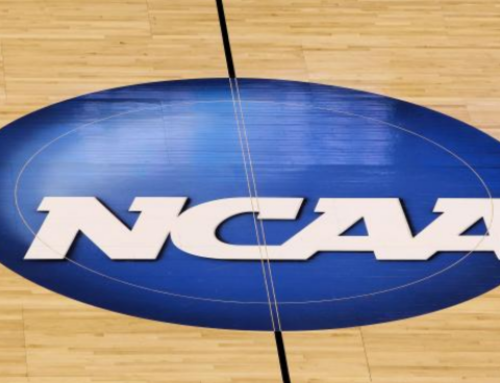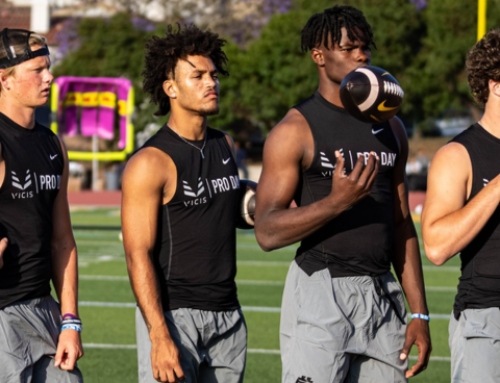Follow the Football Recruiting Checklist to Increase Your Chances of Landing a Scholarship
As a football player, you study tape, lift weights to build strength, practice to perfect your skills and build camaraderie with your teammates, all so you can be your best on game day. It’s a process. Similarly, so is college football recruiting. You have to put in effort every day to reach the goal of securing a roster spot on a collegiate football team. Your first step should be to develop a winning game plan. Thankfully, we’ve done a lot of that work for you.
RELATED: How to Create a Recruiting Video That Coaches Will Watch
The National Collegiate Scouting Association (NCSA) has been helping athletes land roster spots on their collegiate dream teams since 2000. We’ve placed more than 60,000 athletes at their top-fit schools. Based on that experience, here is an ideal college football recruiting timeline, broken down year-by-year for you to follow throughout high school.
Freshman Year: Do your research
- Create a list of 100 prospective schools (research two or three schools each week).
- Send introductory letters to coaches of programs you’re interested in.
- Fill out questionnaires you receive in the mail and send them back right away.
- Follow up with phone calls and letters to coaches.
- Find camps or combines in your area.
- Attend those events and keep track of your accomplishments.
- Film every game that you participate in.
- Try to go on at least three unofficial visits.
RELATED: How a Bad Game Affects Your Recruiting Status
Sophomore Year: Build relationships
- Continue to send letters and make calls to the coaches of programs that interest you.
- Schedule unofficial visits.
- Hone in on the schools you like best from your list of 100.
- Know that Division I and II coaches cannot personally contact you, but you can contact them by sending letters.
- D-III and NAIA coaches can contact you. Stay in touch and build relationships.
- Many high-level D-I schools begin making offers during the summer after your sophomore year.
- Continue filming games, and consider filming a workout.
RELATED: What is a Parent’s Role in Recruiting?
Junior Year: Focus on your targets and spread the word
- Develop a 5-5-5 List: five programs that may be slightly above your reach, five that are a good fit and five back-up schools.
- Follow up with coaches through phone calls, emails and letters to determine where you stand on their lists of recruits.
- Attend combines, camps and one-day college-sponsored camps.
- Make highlight videos.
- If you haven’t heard from Division I coaches, reach out to D-II, D-III or NAIA programs.
Senior Year: Commit to athletic and academic excellence; seal the deal
- Follow up with coaches and schedule official visits. (Note: You are limited to five official visits to D-I and D-II schools.)
- Start your financial aid planning; register for FAFSA (fafsa.ed.gov) as soon as January 1.
- Officially commit to a program. Signing Day is the first Wednesday in February, and signings continue through April 1.
- Find out when you need to report to camp.
- On September 1, D-I coaches can start calling on a weekly basis. In most cases, they will have already made offers.
- D-II, D-III, NAIA schools do most of their recruiting and make offers in the spring of your senior year.
- Junior college is a good option for student-athletes who want to develop academically.
RECOMMENDED FOR YOU
MOST POPULAR
Follow the Football Recruiting Checklist to Increase Your Chances of Landing a Scholarship
As a football player, you study tape, lift weights to build strength, practice to perfect your skills and build camaraderie with your teammates, all so you can be your best on game day. It’s a process. Similarly, so is college football recruiting. You have to put in effort every day to reach the goal of securing a roster spot on a collegiate football team. Your first step should be to develop a winning game plan. Thankfully, we’ve done a lot of that work for you.
RELATED: How to Create a Recruiting Video That Coaches Will Watch
The National Collegiate Scouting Association (NCSA) has been helping athletes land roster spots on their collegiate dream teams since 2000. We’ve placed more than 60,000 athletes at their top-fit schools. Based on that experience, here is an ideal college football recruiting timeline, broken down year-by-year for you to follow throughout high school.
Freshman Year: Do your research
- Create a list of 100 prospective schools (research two or three schools each week).
- Send introductory letters to coaches of programs you’re interested in.
- Fill out questionnaires you receive in the mail and send them back right away.
- Follow up with phone calls and letters to coaches.
- Find camps or combines in your area.
- Attend those events and keep track of your accomplishments.
- Film every game that you participate in.
- Try to go on at least three unofficial visits.
RELATED: How a Bad Game Affects Your Recruiting Status
Sophomore Year: Build relationships
- Continue to send letters and make calls to the coaches of programs that interest you.
- Schedule unofficial visits.
- Hone in on the schools you like best from your list of 100.
- Know that Division I and II coaches cannot personally contact you, but you can contact them by sending letters.
- D-III and NAIA coaches can contact you. Stay in touch and build relationships.
- Many high-level D-I schools begin making offers during the summer after your sophomore year.
- Continue filming games, and consider filming a workout.
RELATED: What is a Parent’s Role in Recruiting?
Junior Year: Focus on your targets and spread the word
- Develop a 5-5-5 List: five programs that may be slightly above your reach, five that are a good fit and five back-up schools.
- Follow up with coaches through phone calls, emails and letters to determine where you stand on their lists of recruits.
- Attend combines, camps and one-day college-sponsored camps.
- Make highlight videos.
- If you haven’t heard from Division I coaches, reach out to D-II, D-III or NAIA programs.
Senior Year: Commit to athletic and academic excellence; seal the deal
- Follow up with coaches and schedule official visits. (Note: You are limited to five official visits to D-I and D-II schools.)
- Start your financial aid planning; register for FAFSA (fafsa.ed.gov) as soon as January 1.
- Officially commit to a program. Signing Day is the first Wednesday in February, and signings continue through April 1.
- Find out when you need to report to camp.
- On September 1, D-I coaches can start calling on a weekly basis. In most cases, they will have already made offers.
- D-II, D-III, NAIA schools do most of their recruiting and make offers in the spring of your senior year.
- Junior college is a good option for student-athletes who want to develop academically.
RECOMMENDED FOR YOU
Create A Free Recruiting Profile Today!
CaptainU helps athletes & parents not only be proactive but also to manage and take control of their entire recruiting journey.










